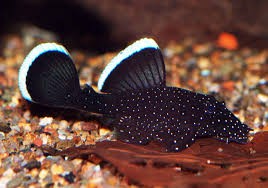WHITE SEAM ANCISTRUS (L183 ANCISTRUS DOLICHOPTERUS)
Full Description
In the genus Ancistrus there is a whole series of species which show a pattern of markings consisting of white dots on a dark grey or black background. A few of these species in their youth even show a white border on the tail fin. However at the moment I know of only four species that, at least as juveniles, show not only fine white spots but also a fine white edging of almost regular thickness on the dorsal fin as well as the tail fin and can therefore can rightly be described as White seam bristlenose. This group of relatives we speak of is the so-called Ancistrus hoplogenys group whose representatives all come from the Amazon region of Brazil. We are talking about not only Ancistrus hoplogenys but also Ancistrus dolichopterus and certainly other, as yet undescribed, species which nevertheless are known by the code numbers L088 and L071. The latter species have, because of their wide distribution, acquired at least a further two L numbers: L181 and L249. In the following I would like to introduce these four bristlenose catfish and show the differences between them.
Ancistrus dolichopterus or L 183 – the genuine Blue Bristlenose or White seam Bristlenose.
The only Bristlenose from this group that is imported frequently and in greater numbers is Ancistrus dolichopterus, which is also known as L183. This is a very attractive fish even in adulthood and occurs in the lower and middle course of the Rio Negro in quite varied types of waters (see Romer 1990). Until recently L183 was mostly still described incorrectly as Ancistrus hoplogenys. However there is no longer any doubt that White seam bristlenose is much more comparable to Ancistrus dolichopterus (see Seidel 2004). The species name translated means “with long fin” and is an allusion to the large number of fin rays in comparison to other Ancistrus species, being supported by 8-10 soft rays while in almost all other representatives of this genus 7-8 rays is the rule. This high number of dorsal rays is also the most noticeable difference from the other three White Seam bristlenoses pictured here. Furthermore it is the only one of the four species to have a white band on the dorsal and tail fin even in adulthood. As well as this the background colour of the species can be very variable, from pitch black to whitish or blue grey and also the spots can be white, bluish or hardly visible. The nickname blue bristlenose which is more commonly used in Germany is linked with Ancistrus dolichopterus because of the blue shimmer which is not always clearly evident.
In its earliest youth, Ancistrus dolichopterus distinguishes itself from the very similar L071, which loses the white fin bands in adulthood, only by the number of fin rays. As far as science is concerned these two different species are not separated, since Ichthyologists do not have the luxury afforded to aquarists of being able to observe live fish and their colour at all stages of life. And so Fisch-Muller (1999, 2003) attributes to A. dolichopterus a much larger area of distribution than this species has in reality. Fisch-Muller concedes though, that A. dolichopterus never has as high a number of fin rays as those occurring in the Rio Negro basin. In my opinion the real A. dolichopterus (L 183) has never yet been detected anywhere else. According to Romer they can be found in the river system of the Rio Negro in black water and white water as well as in some types of clear water (see Evers & Seidel 2002, S 70ff). This species typically lives in water of around 26-32 C depending on season; the water is very soft and most often very noticeably acidic.
Sexually mature males of Ancistrus dolichopterus can develop a powerful “antler”, which is not typical and which often has multiple branched tentacles at its end. A special characteristic of the species furthermore is that even the females show unusually numerous, pronounced tentacles. Whereas females of other Ancistrus species mostly have only few short tentacles along the edge of the snout, the L183 females often also have somewhat longer and even branched outgrowths of skin at the front of the head, because of which the differentiation of sexes just before sexual maturity, which in many Ancistrus species is easily possible, is made very difficult in this species. The A. dolichopterus, which at the moment are always shipped from Manaus, are as a rule not more than 10-12 cm long and often already sexually mature. In the wild however they can grow significantly bigger and reach lengths up to an unbelievable 25-30 cm. So far I have only once set eyes on such big fish. What was noticeable with these fish was that even at this size they were still just as attractively marked as juvenile specimens can be.
The care of A. dolichopterus demands great attention from the outset, as the newly imported fish are still very frail. Once they are acclimatized, the fish can be kept without any problem in harder water. Soft water is admittedly best with acidic pH in the region of 5.0 – 6.5, which one should give to the fish in any case for breeding. In this respect, this species is significantly more demanding than the other three, whose breeding is still possible at a somewhat higher pH. In the first few weeks of life the young fish have really very few spots and a vertical white seam on the tail fin which disappears shortly thereafter.
1 in stock

